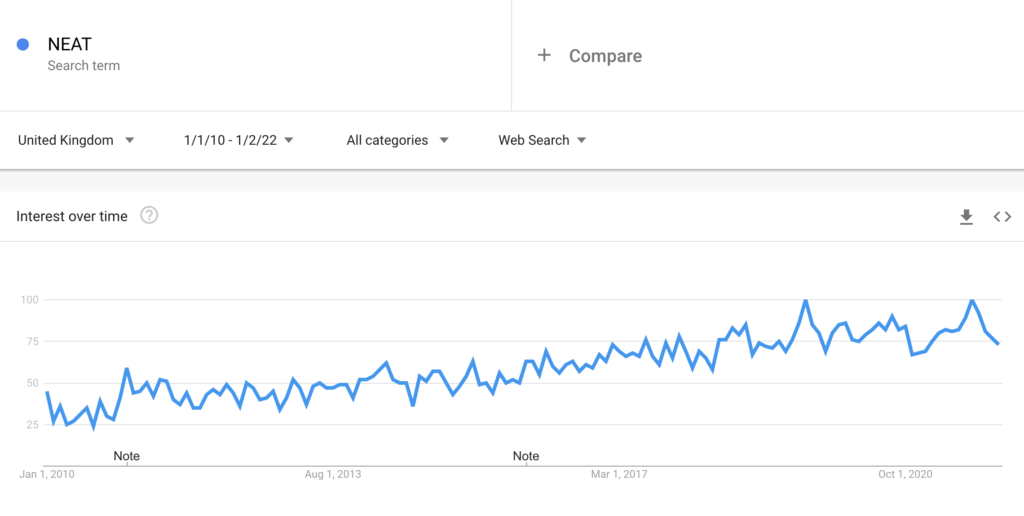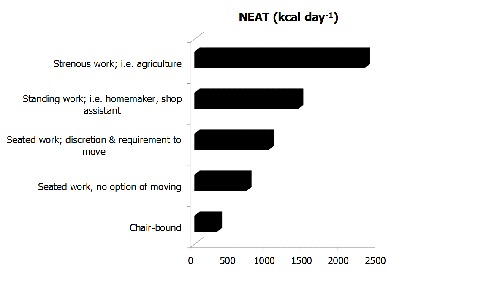- How Much Weight Can You Realistically Lose in 3 Months? - January 14, 2024
- How To Lose 1kg a Week (Guaranteed) - August 20, 2023
- How To Count Calories (or Estimate) and Stay on Track When Eating Out at Restaurants - July 25, 2023
If you’re someone that’s thought about losing weight before, your first thought has probably been ‘i need to start running’ or ‘I should do HIIT classes’ or something equally strenuous. Running, classes, cycling, swimming and any other high intensity is great IF you enjoy it and you’re going to stick to long term, but as a weight-loss intervention, they often fail/
Why?
Because they require a big time commitment and lots of willpower. Plus, people that take these things up for weight don’t genuinely enjoy them, so will always eventually quit. There’s got be a better way…
WHAT IS NEAT?
N.E.AT stands for Non-exercise Activity Thermogenesis.
This sounds complicated, but it really just means any activity that you do that burns calories that isn’t ‘formal’ exercise.
This could be anything from (but not limited to);
- Walking to the car, bus or train station
- Walking around the house
- Walking around the shops
- Just going for a walk
- Standing instead of sitting
- Fidgeting
- Cleaning/vacuuming the house
- Washing the car
- Working on the car
- Doing DIY
- Painting
- Doing gardening
- Cooking
- Playing with the kids
- Yoga
- Dancing
- Stretching
- Carrying groceries
- Building furniture
- Playing Nintendo Wii/Switch games
- Putting up Christmas decorations
Most people wouldn’t consider any of these things as ‘exercise’, but rather [arts of normal everyday life. At least they should be, most people aren’t maximizing their NEAT either because they’re not doing these things or not doing them often enough.
For me, the two key examples that are easy to incorporate are standing and walking.
The majority of us spend most of our day in a seated position, think about it; we get up, get ready for work, sit in the car or on the train, get to the office and sit in a chair all day, go home sitting in the chair or on the train, then sit on the sofa all evening watching Netflix and playing on our phones.
Within a day, there are dozens of opportunities to ensure you burn more calories, without necessarily making a huge time commitment or psyching yourself up to do strenuous activity.
This 2017 study carried out on 18 office workers found that switching between sitting AND standing meant burning more calories throughout the day
“Alternating positions to achieve the recommended 4h/day of standing could result in an additional 56.9 kcal/day for an 88.9kg man and 48.3 kcal/day for a 75.5kg woman”
Gibbs et al
This might not sound like much over the course of a day, but for a 90kg man, this would mean approximately an additional 300 calories burned over 5 days (the working week), or 1,200 calories over the course of a month. This technically equates to around 0.3lbs per month simply by standing for half the day which takes virtually zero effort.
WHY IS NEAT GETTING POPULAR?
The Endocrinologist James Levine is widely credited with coining the term ‘Non-Exercise Activity Thermogenesis and in this 2003 paper, described it as
“the energy expended that is not from sleeping, eating or sports-like exercise. It ranges from the energy expended walking to work, typing, performing yard work, undertaking agricultural tasks and fidgeting”
If we look at Google Trends, since the phrase was coined, it has gradually increased in popularity

I’d go as far to say that James Smith and Diren Kartal, UK-based fitness influencers, have really accelerated the awareness and popularity of NEAT over the last couple of years and have popularized the hashtag #neatup247 on Instagram and Twitter
#neatup247 basically refers to the fact that being aware of your NEAT throughout the day in terms of all the micro-movements you make can add-up over time to have a big effect on weight loss.
NEAT isn’t something you do ‘a few times a week’ like a gym workout or your favourite sport, it’s something that you’re doing constantly, and while one ‘NEAT event’ may only burn a few calories, the daily, weekly and monthly of those calories is significant.
I’d argue that NEAT is also getting popular because, well, it’s easy…
Traditionally, when you think of weight loss and exercise, you thin grueling gym sessions, marathon training, and 50 lengths of the Olympic Pool. The truth is, while all those pursuits have benefits IF you enjoy them, they’re really not the best option for weight loss.
Weight loss is all about calories in vs calories out, and by doing regular intense exercise sessions you’re certainly going to be burning a LOT of calories, but you’re also going to need to replace those calories. Getting the balance right is tricky, especially when your hunger levels are going to be through the roof.
This is where NEAT has an advantage. Yes, NEAT (walking for example) may only burn a fraction of the calories of running, Crossfit or Cycling within a given session (1 hour let’s say), but it has two clear advantages;
- It’s not going to stimulate hunger anywhere near as much as those other activities, meaning it’s easier to control the ‘calories in’ part of the equation
- It’s easy to do everyday. How many times a week can you (or do you want to) do an intense run or gym session? 2, possibly 3 max. A 30-60 walk is easy to do everyday. It doesn’t require any motivation, willpower stretching, warm up or wearing special workout clothes
This is why for me, and lots of other people, NEAT wins every time.
Here’s an example of how the calories burned from an hour of NEAT (walking) might stack up vs running over the course of a week
| ACTIVITY | MON | TUES | WED | THURS | FRI | SAT | SUN | TOTAL |
| Running | 400 | 400 | 400 | 1,200 | ||||
| NEAT | 250 | 250 | 250 | 250 | 250 | 250 | 250 | 1,750 |
N.B. Actual calories burned will depend on a multitude of different factors, but these numbers are illustrative
It’s easy to see how NEAT wins here.
One other benefit to consider is the sustainability of weight loss. If you start doing three runs a week to lose weight and it works, great. But how long can you keep that up for? Most people probably don’t want to run three times a week for the rest of their lives. But a 30-60 minute walk every day? Easy.
HOW MANY CALORIES DOES NEAT BURN?
This really depends on the form of NEAT that you’re doing, how long and how often you do it for and a bunch of other factors like your current weight.
The easiest form of NEAT to quantify is walking, and this study found that participants burned between 20 and 110 calories walking for 1,600 meters.
I’ve put together some calorie burn estimates based on the number of steps and current body weight to give you an idea of what you could expect to burn from walking.
| 50kg | 60kg | 70kg | 80kg | 90kg | 100kg | 110kg | 120kg | |
| 1000 STEPS | 30 | 35 | 40 | 46 | 52 | 58 | 64 | 69 |
| 2000 STEPS | 60 | 70 | 80 | 92 | 104 | 116 | 128 | 138 |
| 3000 STEPS | 90 | 105 | 120 | 138 | 156 | 174 | 192 | 207 |
| 4000 STEPS | 120 | 140 | 160 | 184 | 208 | 232 | 256 | 276 |
| 5000 STEPS | 150 | 175 | 200 | 230 | 260 | 290 | 320 | 345 |
| 6000 STEPS | 180 | 210 | 240 | 276 | 312 | 348 | 384 | 414 |
| 7000 STEPS | 210 | 245 | 280 | 322 | 364 | 406 | 448 | 483 |
| 8000 STEPS | 240 | 280 | 320 | 368 | 416 | 464 | 512 | 552 |
| 9000 STEPS | 270 | 315 | 360 | 414 | 468 | 522 | 576 | 621 |
| 10000 STEPS | 300 | 350 | 400 | 460 | 520 | 580 | 640 | 690 |
| 11000 STEPS | 330 | 385 | 440 | 506 | 572 | 638 | 704 | 759 |
| 12000 STEPS | 360 | 420 | 480 | 552 | 624 | 696 | 768 | 828 |
| 13000 STEPS | 390 | 455 | 520 | 598 | 676 | 754 | 832 | 897 |
| 14000 STEPS | 420 | 490 | 560 | 644 | 728 | 812 | 896 | 966 |
| 15000 STEPS | 450 | 525 | 600 | 690 | 780 | 870 | 960 | 1035 |
WHAT ENVIRONMENTAL FACTORS AFFECT NEAT?
Of course, anyone can set a step goal and aim to fulfill it consistently, but the ability to achieve it, and the ease of achieving it are going to be impacted by environmental factors, most of which are outside of your control.
Occupation
Arguably the biggest factor affecting NEAT on a daily basis is occupation. The simple fact is that some occupations require a higher energy output than others.
This paper compares the NEAT of different occupations and found that an individual with an active occupation can burn up to 1,500 more calories per day than someone with a sedentary job.
That equates to roughly 3lbs of weight loss per week if you were to switch from a sedentary to a very active job.
Socio-Economic Status
One thing that is required in order to up your NEAT is time. Time is of course more abundant for wealthy individuals. In fact, this study reports that highly educated groups are three times more likely to be physically active than their less-educated counterparts.
The unfortunate truth is that lower-income individuals may need to work more hours or more jobs to make ends meet, leaving little spare time for physical activity or NEAT.
Season
The same study cites seasonality as another important factor in determining how many calories are burned through NEAT.
“Time spent in activity is twice as likely during the summer as compared to winter months”
Of course, this means that people living in colder climates are less likely to expend energy through neat
Location
One extra one I’d like to throw in the mix is location. NEAT is of much easier for people living in certain locations. If you live in the countryside, walking is probably a simple and enjoyable activity, if you live in the middle of a city this might not be the case, particularly of that city is dangerous at night.
IS WALKING REALLY NEAT?
Yes, of course, it depends on your definition, but according to Levine who coined the term, NEAT includes walking.
It doesn’t really make sense to exclude walking from your NEAT activity, especially because it’s hard to measure non-walking NEAT.
A step counter will however take into account non-walking movement, for example the motion of your arm if you’re washing the car. Given that this kind of NEAT has the potential burn the same amount of calories as walking there’s no reason to try and separate it from steps.
There’s also no reason to try to separate your ‘incidental’ steps, i.e. the steps you make walking around the supermarket from your ‘intentional’ steps, they all count!
HOW YOU CAN INCREASE NEAT?
Luckily NEAT is really easy to increase, at least conscious NEAT is.
Unconscious NEAT like fidgeting, stretching and general minute-by-minute micro-movements is very difficult to intentionally increase. Generally, this type of movement happens coincidentally, usually when the body is in a state of energy surplus.
There are a few key ways you can increase your conscious NEAT
- Set a step target
You can track your daily activity with a fitness tracker like a Fitbit or an Apple Watch. Sr yourself a CONSERVATIVE daily step target.
I’d recommend starting off with 4,000 steps per day, for most people this equates to around 30 minutes of walking which should be easy to fit into your schedule no matter how busy you are.
- Stand instead of sitting
As we know, standing burns more calories than sitting so invest in a standing desk. This will also benefit your posture
- Take the Stairs
Of course, taking the stairs as opposed to the escalator or lift will mean extra steps added to your tally, but walking upstairs has the added benefit of making your heart pump that but faster, meaning you expending more energy.
SUMMARY
If you didn’t know about NEAT, you do now.
If you’re trying to lose weight, stop assuming you need to do endless, sweaty HIIT workouts, because that really isn’t necessary.
Combining some moderate calorie restriction with a few thousand more steps per day is likely going to be enough for most average people to start tipping the scales in your favour.
REFERENCES
Energy expenditure of deskwork when sitting, standing or alternating positions:
https://pubmed.ncbi.nlm.nih.gov/27515973/
Non-exercise activity thermogenesis
https://pubmed.ncbi.nlm.nih.gov/14692603/
The Role of Non-exercise Activity Thermogenesis in Human Obesity: https://www.ncbi.nlm.nih.gov/books/NBK279077/
NEAT – non-exercise activity thermogenesis – egocentric & geocentric environmental factors vs. biological regulation:


Leave a Reply